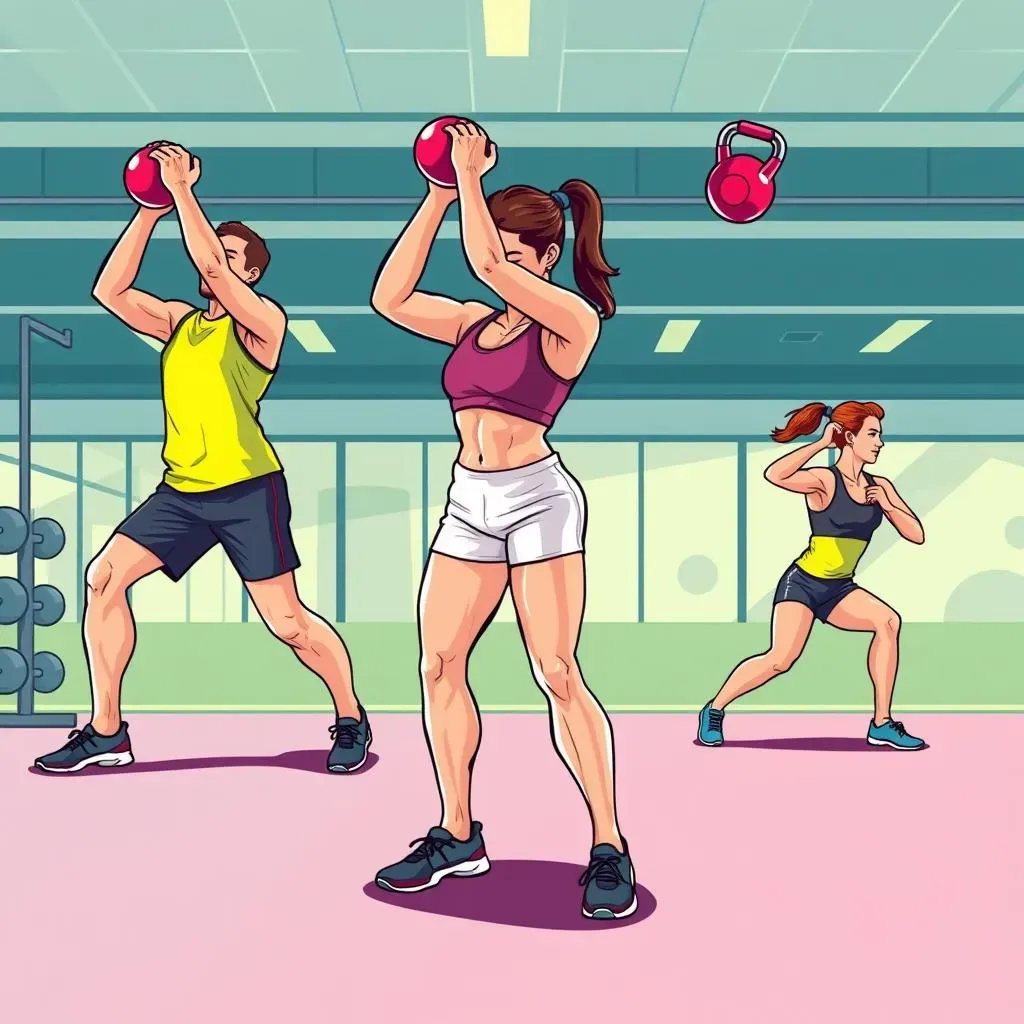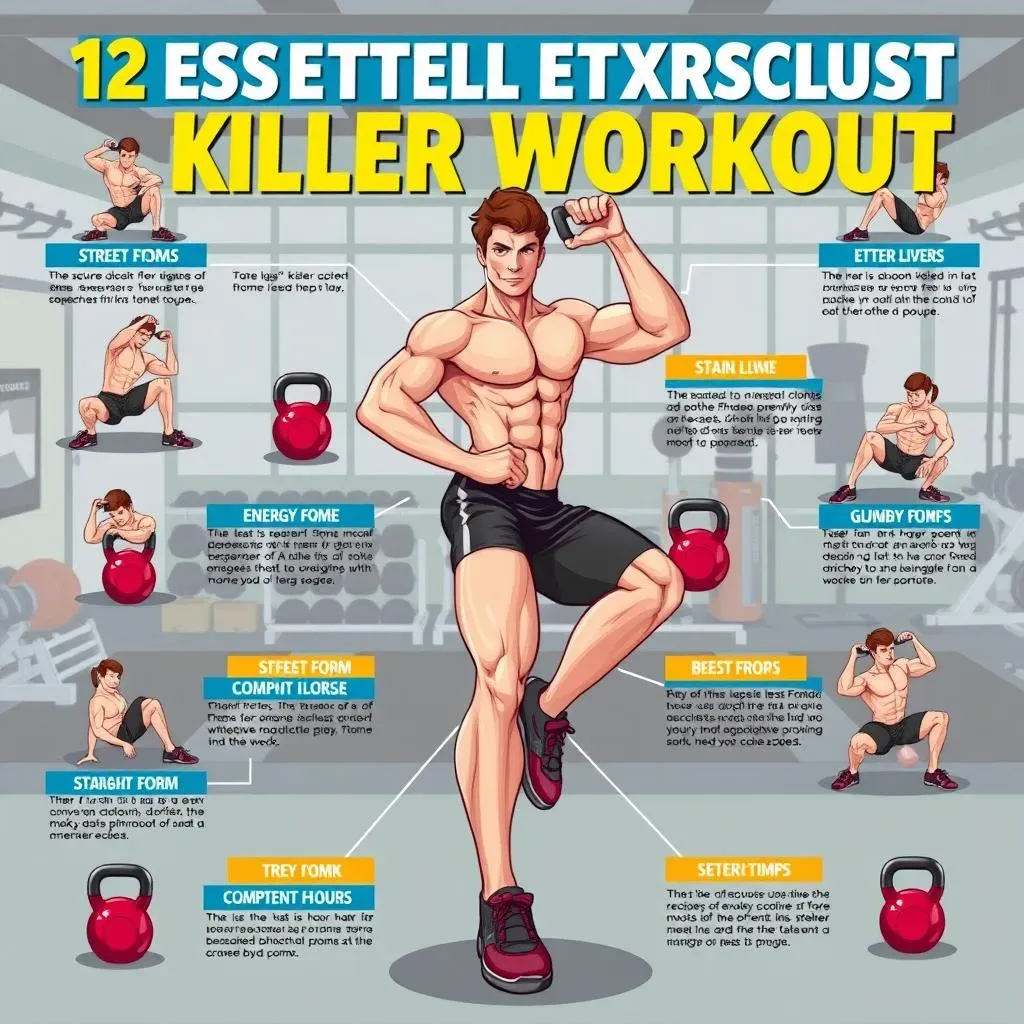Table of Contents
Ready to ditch the boring leg day routine? I'm here to tell you, it's time to grab a kettlebell! Forget those clunky machines; kettlebells are the secret weapon for building seriously strong and sculpted legs. This isn’t just about looking good; it’s about unlocking real power and functional fitness. With a kettlebell, you're not just lifting weight, you’re engaging your core, improving your balance, and getting a full-body workout all at once. This article is your go-to guide for a killer legs workout with kettlebells. We'll start by looking at why kettlebells are so effective for leg training. Then, we'll cover the basic moves you need to know to stay safe. Finally, I’ll show you 12 awesome kettlebell exercises that will make your legs feel like they're made of steel. Get ready to feel the burn, because we're about to take your leg day to a whole new level!
Why Kettlebells Are Awesome for Your Legs Workout

Why Kettlebells Are Awesome for Your Legs Workout
More Than Just a Weight
Okay, so you've seen people swinging kettlebells around, maybe you've even tried it. But have you ever really thought about why they're so great for your legs? It’s not just about lifting a heavy thing. Kettlebells are like the Swiss Army knife of fitness. They're awesome because they work your legs in a way that dumbbells and barbells just can't match. The shape of the kettlebell forces you to use your whole body, especially your core, to control the weight. This means you're not just building leg strength; you're building functional strength that translates to real-world movements. Think about it: carrying groceries, climbing stairs, chasing after your dog – all these things become easier when you train with kettlebells.
Plus, kettlebells are fantastic for improving your balance and coordination. The dynamic movements you do with kettlebells, like swings and lunges, engage all those tiny stabilizer muscles that you never knew existed. This makes your legs stronger, but also more stable and less prone to injury. It's like giving your legs a super-powered upgrade. And let's be honest, who doesn't want super-powered legs? They are an excellent tool for developing explosive power too. Imagine how much better you'd be at jumping, sprinting, or just generally feeling like a more athletic version of yourself. That's the power of a kettlebell legs workout.
Functional Fitness is the Key
It is not just about raw power, let’s be honest. It's about how those muscles work together. Kettlebells excel at this. The way the weight is distributed, it's not just a straight up and down lift. It’s about using your legs, core, and even your arms to control the kettlebell as it moves through space. This is why kettlebells are so great for building functional strength. You're not just isolating muscles, you're training them to work together as a team. This is how your body actually moves in real life. I mean, when was the last time you ever bicep-curled a bag of groceries? Never, right? But you definitely squatted, hinged, and swung. That's what makes kettlebell training so effective, they simulate real life movements to make you stronger in your day to day.
The fluid, dynamic movements you perform with kettlebells mean your body needs to work harder to control the weight. This leads to a more intense workout that builds muscle and also improves your cardiovascular fitness. Forget the treadmill; grab a kettlebell and start swinging. You will feel the difference. And the best part? Kettlebells are super versatile. You can do a full leg workout with just one kettlebell. You can work out at home, at the gym, or even outside. They're portable, affordable, and incredibly effective. What else could you ask for?
Benefit | Why it Matters |
|---|---|
Functional Strength | Improves real-world movements like lifting and carrying. |
Core Engagement | Strengthens your midsection for better stability. |
Improved Balance | Reduces the risk of falls and injuries. |
Cardio Boost | Increases heart rate and improves endurance. |
Versatility | Can be used anywhere, with minimal equipment. |
Kettlebell Training Basics: Form and Safety First

Kettlebell Training Basics: Form and Safety First
The Foundation of Kettlebell Success
Alright, before you start swinging that kettlebell like a madman, let's talk about the real deal: proper form. It's not about how much weight you can lift; it's about how well you can lift it. Think of it like building a house. You wouldn't start with the roof, would you? No way! You'd start with a solid foundation. Same goes for kettlebell training. Good form is your foundation. It protects you from injury, and it makes sure you’re actually working the right muscles. I know it might seem boring, but trust me, this is where the magic happens. If you rush this part, you'll be paying for it later with aches, pains, and possibly a trip to the doctor. And nobody wants that.
So, what does good form look like? It's about keeping your back straight, your core engaged, and your movements controlled. It’s not about speed; it’s about precision. Imagine you're trying to balance a book on your head while walking. You wouldn't just throw yourself around; you’d move with intention and control. That’s the same mindset you need for kettlebells. We want smooth, controlled movements, not jerky, wild ones. Remember, quality over quantity. It's better to do five reps correctly than ten with bad form. So, take your time, focus on your body, and make sure every rep counts.
Safety is Key
Now, let's get real about safety. Kettlebells, while awesome, are also heavy hunks of metal. If you don't respect them, they will definitely let you know. So, first things first, always start with a weight that you can comfortably handle. I know you might be tempted to go for the biggest one you can find, but resist that urge. It's like trying to run a marathon without ever having jogged a mile. You’ll just end up hurting yourself. Start light, get comfortable with the movements, and then gradually increase the weight as you get stronger. It's a marathon, not a sprint. And I am not talking about the marathon you can run, I am talking about the marathon of your fitness journey.
Another key point? Always warm up before you start your workout. Your muscles need to be ready for action, like a race car that needs to warm up its engine. A few minutes of light cardio, some dynamic stretches, and you'll be good to go. Also, pay attention to your body. If something feels wrong, stop. Don't try to push through pain. It's your body’s way of saying, "Hey, something's not right!" Listen to it. And of course, if you're new to kettlebells, it's a smart idea to get some guidance from a qualified trainer. They can show you the proper form and make sure you're doing everything safely. It’s like having a map when you’re exploring a new place. It just makes the journey much easier and safer. Remember, safety isn't just about avoiding injuries; it's about making sure you can keep training for a long time.
Essential Kettlebell Tips
Before we jump into the actual exercises, let's quickly go over some essential kettlebell tips. These are like the secret codes that will make your training more effective and safer. First, grip is crucial. Hold the kettlebell firmly, but not so tightly that you’re turning your knuckles white. It's a balance between having a good grip and not straining your hands. Second, keep your core engaged throughout the entire workout. Think about bracing your abs like someone is about to punch you in the stomach. This will protect your back and make your movements more powerful. Third, remember to breathe. Don't hold your breath when you're lifting. Exhale on the effort, inhale on the release. It's like a rhythm that will make each movement more efficient.
And finally, don't be afraid to modify the exercises. If something feels too hard, make it easier. If it feels too easy, make it harder. It’s about finding the right level of challenge for you. This is your workout, your journey, so make it work for you. Remember, kettlebell training is a journey, not a destination. It’s about progress, not perfection. So, be patient with yourself, stay consistent, and enjoy the process. And most importantly, have fun! It's much easier to stick to a workout routine if you actually enjoy it. So, let's get to those exercises and start building some awesome leg strength!
- Grip: Firm but not too tight.
- Core: Always engaged.
- Breathing: Exhale on effort, inhale on release.
- Modifications: Adjust exercises to suit your level.
12 MustDo Kettlebell Exercises for a Killer Legs Workout

12 MustDo Kettlebell Exercises for a Killer Legs Workout
The King of Kettlebell Leg Exercises: The Swing
Alright, let's get into the good stuff! We're starting with the king of all kettlebell exercises, the swing. If you could only do one kettlebell exercise for your legs, this would be it. It’s not just about swinging a weight; it's about learning how to generate power from your hips. Think of your hips as a hinge. You’re not squatting; you’re hinging at the hips, pushing them back as you swing the kettlebell down, and then powerfully snapping them forward to drive the kettlebell up. The swing is a full-body movement, but it hits your hamstrings, glutes, and core like a champion. It will make you feel like a total powerhouse when you get it right. It might feel a bit awkward at first, but with practice, you’ll start to feel that explosive power. And trust me, that feeling is addictive.
When you do your swings, keep your back straight, your core tight, and your eyes forward. Don't let the kettlebell pull you down. You're controlling it, not the other way around. The movement should be smooth and continuous, like a pendulum swinging back and forth. Don’t try to lift the kettlebell with your arms; the power should come from your hips. If you’re feeling it more in your lower back, it means you’re not hinging properly. So, take a step back, check your form, and try again. You’re not going to master this in one day, but with consistency, you'll get there. The swing is the foundation for so many other kettlebell movements, so it’s worth spending the time to get it right.
Squats and Deadlifts: The Cornerstones
Next up, we have the squat and the deadlift. These are the cornerstones of any good leg workout, and they’re even better with a kettlebell. The goblet squat is a fantastic option. You hold the kettlebell close to your chest, like you're hugging it, and then squat down. This helps keep your back straight and your chest up, which is crucial for proper form. The goblet squat is great for building overall leg strength and working those quads and glutes. It's a simple but incredibly effective exercise that will make you feel the burn in all the right places.
Then there's the kettlebell deadlift. This exercise is all about picking up that kettlebell with proper form. You're hinging at your hips, keeping your back straight, and lifting with your legs. The deadlift is a powerhouse move that works your hamstrings, glutes, and lower back. It's essential for building overall strength and stability. The key is to keep the weight close to your body and to avoid rounding your back. A good deadlift is a beautiful thing, and with practice, you'll be able to do it with confidence and power. These two exercises alone, the squat and the deadlift, can form the base of an amazing leg workout. But we’re not stopping there, we’ve got more to add!
Exercise | Primary Muscles Worked | Benefits |
|---|---|---|
Kettlebell Swing | Hamstrings, Glutes, Core | Power, Endurance, Functional Strength |
Goblet Squat | Quads, Glutes, Core | Leg Strength, Posture, Stability |
Kettlebell Deadlift | Hamstrings, Glutes, Lower Back | Strength, Stability, Core Engagement |
Lunges, Step-Ups, and More: Expanding the Arsenal
Now, let's expand our arsenal with some more awesome kettlebell leg exercises. Lunges are a classic, and they're even more challenging with a kettlebell. You can do forward lunges, reverse lunges, or lateral lunges. Holding the kettlebell in a goblet position or by your side adds extra resistance and challenges your balance. Lunges are great for working each leg individually, which helps to correct imbalances and build stability. They also target your quads, glutes, and hamstrings, making them a fantastic all-around leg exercise.
Step-ups are another fantastic exercise that often gets overlooked. Grab a box or a bench, hold the kettlebell in a goblet position or by your side, and step up. This is amazing for building single-leg strength and stability. It’s like climbing stairs, but with extra weight. You can also try variations like the reverse lunge, or the split squat. And don't forget about the single-leg deadlift. This is a balance challenge, but it is incredibly effective for working your hamstrings and glutes. It's like a balancing act, but it builds real strength and stability. These exercises will add variety to your workout and challenge your legs in new and exciting ways. It's all about keeping your body guessing and pushing your limits.
Finally, let's throw in some bonus exercises to round out our routine. Kettlebell pistols squats are a killer, but they require some practice. They are the ultimate test of single-leg strength and balance. You can also add kettlebell glute bridges, which are great for targeting your glutes. And if you want to challenge your calves, try kettlebell calf raises. There are so many ways to use a kettlebell to work your legs, and this is just the beginning. It is about finding what works for you and sticking with it. Remember, consistency is the key to success. So, grab your kettlebell, pick a few exercises you like, and get to work! You’ll be amazed at how quickly you can build strength, power, and confidence with a kettlebell leg workout.
- Lunges: Forward, reverse, lateral for balance and strength.
- Step-Ups: Great for single-leg power.
- Single-Leg Deadlifts: Balance and hamstring strength.
- Pistol Squats: Advanced single-leg strength.
- Glute Bridges: Target glutes.
- Calf Raises: Develop calf muscles.
Putting It All Together: Your Legs Workout with Kettlebells Plan

Putting It All Together: Your Legs Workout with Kettlebells Plan
Building Your Workout
Okay, so we've covered why kettlebells are awesome and the key exercises you need to know. Now, let's get down to the nitty-gritty: building your actual workout plan. It's like having all the ingredients for a delicious meal, but you need a recipe to put it all together. Don't worry, I’m not going to make you follow some crazy, impossible plan. We're going to start simple and gradually build up. The key is to be consistent and listen to your body. This isn't a race; it's a journey, and we want to make sure it’s a fun one. So, let’s get you started with a plan that is both effective and enjoyable.
First, think about your fitness level. Are you a total newbie, or have you been working out for a while? If you’re just starting out, focus on mastering the basic moves first. Start with lighter weights and focus on your form, not the amount of weight you are using. You will be tempted to increase the weight, but resist this. Once you've got the basics down, you can start adding more challenging exercises and increasing the weight. Remember, it's all about progress, not perfection. And if you're more experienced, feel free to challenge yourself with more advanced variations and heavier weights. You can also play around with the rep ranges and sets to match your goals. The goal here is to find the right balance for you, making it both challenging and fun.
Sample Workout Structure
Let's break down what a typical workout session might look like. A good workout should start with a warm-up. This could be some light cardio, like jumping jacks or jogging in place, followed by some dynamic stretches. Then, you'll move into the main workout, which should include a mix of exercises like swings, squats, deadlifts, and lunges. Aim for 3-4 sets of 8-12 repetitions for each exercise. If you’re a beginner, start with fewer sets and reps, and gradually increase them as you get stronger. Remember, quality over quantity. It’s better to do fewer reps with good form than many with bad form. And don't forget to cool down with some static stretches at the end. This will help your muscles recover and reduce soreness.
Remember, the key is to keep it varied. Don't do the same workout every single time. Mix it up! Try different exercises, vary the rep ranges, and play around with the weights. This will keep your body guessing and prevent you from hitting a plateau. It will also keep you from getting bored! And most importantly, listen to your body. If you're feeling tired, take a rest day. If something hurts, stop. It's your body's way of telling you something is wrong. Don't try to push through pain; it’s always better to take a break and come back stronger. Consistency is key here. So, aim for at least 2-3 kettlebell leg workouts per week. You don’t have to do a marathon workout each time. Even short, effective workouts can make a big difference.
Workout Phase | Description | Time |
|---|---|---|
Warm-up | Light cardio and dynamic stretches | 5-10 minutes |
Main Workout | Mix of kettlebell leg exercises | 30-45 minutes |
Cool-down | Static stretches | 5-10 minutes |
Progression and Consistency
Now, let’s talk about progression. As you get stronger, you'll need to increase the challenge to continue making progress. This could mean increasing the weight, adding more reps or sets, or trying more advanced variations of the exercises. It's like leveling up in a video game. You don't want to stay at the same level forever, do you? So, keep pushing yourself, but do it gradually. Don't try to jump from one level to ten overnight. It's a step-by-step process. Be patient with yourself, and celebrate each small victory along the way. You’ll be surprised at how much progress you can make with consistent effort.
And finally, consistency is the secret sauce. It’s not about being perfect; it’s about showing up and doing the work. There will be days when you don't feel like working out, and that's okay. But don't let those days turn into weeks or months. Make it a habit. Schedule your workouts into your calendar. Treat them like an important appointment that you can't miss. Make it fun by listening to your favorite music or working out with a friend. The important thing is to find a routine that works for you and stick with it. Remember, the goal is not to achieve perfection, but to get better each day. And with a little bit of dedication and a lot of kettlebell swinging, you will reach your goals. So, get out there, and start building those strong, powerful legs!